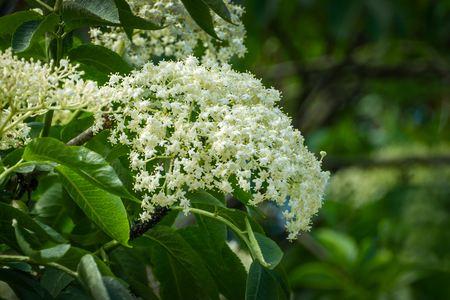Profile
The black elder(Sambucus nigra) has been known since time immemorial. Also known as elder, elderberry or black lilac, it bears large white flowers in early summer, which not only look beautiful but also taste delicious. But it is not only used in the kitchen, it is also very popular as a medicinal plant.
Utilisation

The black elder has a long tradition as a medicinal plant. Even in ancient times, it was considered a universally applicable medicinal plant. In ancient Greece, ripe elderberries were used as a diuretic and laxative. Centuries later, elderberry was used to treat fever and respiratory infections.
Elderberry was considered the "poor man's pharmacy" due to its many uses for illnesses and as an important source of vitamin C. Almost all parts of the plant, leaves, flowers, fruits, bark and roots were used.
Despite this high status in traditional medicine, only a few scientific studies are available. In laboratory tests, an aqueous extract of elderflower showed evidence of an immunomodulatory effect, while ingredients in the fruit showed antiviral effects.
The pharmaceutical drug that is commercially available today consists of the dried flowers of Sambucus nigra L. and is used as a diaphoretic for colds.
In addition to essential oil, the flowers contain flavonoids, triterpenes, triterpene acids, minerals, tannins and mucilage.
The inflorescences have traditionally been used to make elderberry pancakes or sweet elderflower syrup or dried as a tea for the cold season.
The berries were an important source of vitamins during the harsh winter months. They were and are made into syrup or often boiled down together with other fruits to make elderberry jam and marmalade.
The fresh fruits are not suitable for consumption as they can cause digestive problems and nausea. The ingredients responsible for this are not yet known. However, these substances are rendered harmless by cooking.
Botany
Of the nine elder species worldwide, three are found in Europe and Austria. Two of them are inedible or even poisonous. Only the black elder is partially edible for humans, and is even medicinal. The shrub, rarely a tree, belongs to the Viburnaceae family and grows up to 7 metres high.
The leaves of the elderberry are opposite, pinnate, pointed and serrated at the edges.
In June, the elder develops a sweet odour with its creamy white, yellowish, flat umbels. The black-purple fruits ripen from August to October.
Distribution
The original home of the black elderberry is Central Europe. Today, however, this undemanding shrub can be found almost everywhere in Europe, Asia Minor, western Siberia and the Caucasus. It favours locations on field margins, alluvial forests, fences and hedges as well as rubble areas.
Consequently, the elder prefers moist, loamy soils with a high humus and lime content, but also copes well with other soils.
The elder is a self-pollinating and cross-pollinating species. Birds spread the fine seeds for kilometres in the wild with their droppings.
Service
The preservation of diversity is very important to us, which is why we store around 5,400 samples of seeds and plants in our gene bank. With the gene bank for agricultural crops, medicinal and aromatic plants, we are making a significant contribution to the preservation of biodiversity.
Last updated: 12.07.2024
automatically translated